- ASIC
- 电池管理 IC
- 时钟和时序解决方案
- ESD 和浪涌保护器件
- Automotive Ethernet
- 评估板
- 高可靠性
- 隔离
- 存储器
- 微控制器
- 功率产品
- 射频
- 安全智能卡解决方案
- 传感器技术
- 小信号晶体管和二极管
- 收发器
- 通用串行总线(USB)
- 无线连接
- 英飞凌大中华区生态圈
- 搜索工具
- 技术
- 封装
- 购买渠道
- 概览
- Automotive Ethernet Bridges
- Automotive Ethernet PHY for in-vehicle networking
- Automotive Ethernet Switches for in-vehicle networking
- 概览
- 嵌入式闪存eFlash IP 解决方案
- RAM和Flash多芯片封装MCP解决方案
- F-RAM铁电存储器
- NOR 闪存
- nvsRAM非易失性存储器
- PSRAM伪静态随机存储器
- 抗辐射和高可靠性的存储器
- RRAM阻变存储器
- SRAM静态随机存储器
- 晶圆和裸片存储器解决方案
- 概览
- AC-DC电源转换
- 电动汽车动力系统
- D 类音频放大器 IC
- 非接触式电源和检测 IC
- DC-DC 转换器
- 二极管&晶闸管 (Si/SiC)
- 氮化镓(GaN)
- GaN EiceDRIVER™高速栅极驱动器
- IGBT 产品及驱动器件
- 智能功率模块(IPM)
- LED 驱动芯片
- 电机控制 IC 和驱动
- 高效能功率MOSFET 和 MOS管
- Power modules
- 电源模块
- 保护和监控IC
- Silicon carbide (SiC)
- 智能电源开关
- 固态继电器
- 无线充电 IC
- 概览
- Calypso® 产品
- CIPURSE™ 产品
- 非接触式存储
- 了解 OPTIGA™ 嵌入式加密解决方案
- SECORA™ 安全解决方案
- 安全控制器
- 智能卡模块
- 政府身份证的智能解决方案
- 概览
- REAL3™ 3D ToF 图像传感器
- MOTIX™ MCU (SoC) 基于 Arm® Cortex®-M0,集成半桥驱动器
- 气体传感器
- Inductive position sensors
- 微机电系统麦克风
- 压力传感器
- 雷达传感器
- 磁性位置传感器
- 磁性速度传感器
- 概览
- USB 2.0 外设控制器
- USB 3.2 外设控制器
- USB 集线器控制器
- USB PD 高压微控制器
- USB-C AC-DC 和 DC-DC 充电解决方案
- USB-C 充电端口控制器
- USB-C 供电控制器
- 概览
- AIROC™ 车载无线
- AIROC™ 蓝牙Bluetooth® 和多协议解决方案
- AIROC™ 互联微控制器
- AIROC™ Wi-Fi + Bluetooth® 组合
- 概览
- FM0+ 32 位 Arm® Cortex-M0®+ 微控制器 (MCU) 系列
-
FM3 32 位 Arm® Cortex-M3® 微控制器 (MCU) 系列
- 概览
- FM3 CY9AFx1xK 系列 Arm® Cortex-M3® 微控制器 (MCU)
- FM3 CY9AFx1xL/M/N 系列 Arm® Cortex-M3® 微控制器 (MCU)
- FM3 CY9AFx2xK/L 系列 Arm® Cortex-M3® 微控制器 (MCU)
- FM3 CY9AFx3xK/L 系列超低漏电流 Arm® Cortex-M3® 微控制器 (MCU)
- FM3 CY9AFx4xL/M/N 系列低功耗 Arm® Cortex-M3® 微控制器 (MCU)
- FM3 CY9AFx5xM/N/R 系列低功耗 Arm® Cortex-M3® 微控制器 (MCU)
- FM3 CY9AFxAxL/M/N 系列超低漏电流 Arm® Cortex-M3® 微控制器 (MCU)
- FM3 CY9BFx1xN/R 高性能系列 Arm® Cortex-M3® 微控制器 (MCU)
- FM3 CY9BFx1xS/T 高性能系列 Arm® Cortex-M3® 微控制器 (MCU)
- FM3 CY9BFx2xJ 系列 Arm® Cortex-M3®微控制器 (MCU)
- FM3 CY9BFx2xK/L/M 系列 Arm® Cortex-M3® 微控制器 (MCU)
- FM3 CY9BFx2xS/T 系列 Arm® Cortex-M3® 微控制器 (MCU)
- FM4 32 位 Arm® Cortex-M4® 微控制器 (MCU) 系列
- 概览
-
TriCore™ AURIX™ TC2x安全模块
- 概览
- AURIX™系列 – TC21xL
- AURIX™ 系列 – TC21xSC (无线充电)
- AURIX™ 系列 – TC22xL
- AURIX™系列 – TC23xL
- AURIX™ 系列 – TC23xLA (ADAS)
- AURIX™ 系列 – TC23xLX
- AURIX™ 系列 – TC264DA (ADAS)
- AURIX™系列 – TC26xD
- AURIX™ 系列 – TC27xT
- AURIX™ 系列 – TC297TA (ADAS)
- AURIX™ 系列 – TC29xT
- AURIX™ 系列 – TC29xTT (ADAS)
- AURIX™系列 – TC29xTX
- AURIX™ TC2x仿真器件
- 32 位TriCore™ AURIX™ – TC3x
- 32 位TriCore™ AURIX™ - TC4x
- 概览
- PSOC™ 4 Arm® Cortex®-M0/M0+
- PSOC™ 4 HV Arm® Cortex®-M0+
- PSOC™ 5 LP Arm® Cortex®-M3
- PSOC™ 6 Arm® Cortex-M4®/M0+
- PSOC™ Multitouch Arm® Cortex®-M0
- 32 位 PSOC ™ Control Arm® Cortex ® -M33 MCU
- PSOC™ Fingerprint Arm® Cortex®-M0+
- PSOC™ Automotive 4: Arm® Cortex®-M0/M0+
- PSOC™ Edge Arm® Cortex® M55/M33
- 概览
- 32 位 TRAVEO™ T2G Arm® Cortex®用于车身电子应用
- 用于仪表盘的 32 位 TRAVEO™ T2G Arm® Cortex®
- 概览
- 32 位XMC1000工业微控制器 Arm® Cortex-M0®
- 32 位XMC4000工业微控制器 Arm® Cortex-M4®
- XMC5000 Industrial Microcontroller Arm® Cortex®-M4F
- 32 位XMC7000工业微控制器 Arm® Cortex-M7®
- 概览
- 桥式整流器和交流开关
- CoolSiC™ 肖特基二极管
- 二极管裸片
- 硅二极管
- 晶闸管/二极管模块
- 晶闸管软启动器模块
- 晶闸管/二极管盘
- 概览
- 32-bit PSOC™ Control Arm® Cortex®-M33 MCU
- iMOTION™集成电机控制解决方案
- Embedded Power ICs (System-on-Chip) -146
- MOTIX™电机控制IC用于BLDC电机
- MOTIX™ 电机控制IC,用于有刷直流电机
- MOTIX™ 多半桥IC用于伺服和步进电机
- 概览
- 汽车级MOSFET
- 双 MOSFET
- MOSFET(Si 和 SiC)模块
- N 沟道耗尽型 MOSFET
- N沟道MOS管
- 碳化硅 CoolSiC™ MOSFET
- 250V至600V G14小信号MOS
- 概览
- OPTIGA™ Authenticate
- OPTIGA™ Authenticate NFC 解决方案
- OPTIGA™ Connect – 交钥匙式 eSIM 安全解决方案
- OPTIGA™ Trust
- OPTIGA™ 可信平台模块 (TPM)
- 概览
- EZ-PD™ ACG1F 单端口 USB-C 控制器
- EZ-PD™ CCG2 USB Type-C 端口控制器
- EZ-PD™ CCG3PA Automotive USB-C 和 Power Delivery 控制器
- EZ-PD™ CCG4 双端口 USB-C 和 PD
- EZ-PD™ CCG5 双端口和 CCG5C 单端口 USB-C PD 控制器
- EZ-PD™ CCG6 单端口 USB-C & PD 控制器
- EZ-PD ™ CCG6_CFP 和 EZ-PD ™ CCG8_CFP 双单端口 USB-C PD
- EZ-PD™ CCG6DF 双端口和 CCG6SF 单端口 USB-C PD 控制器
- EZ-PD™ CCG7D 汽车双口 USB-C PD + DC-DC 控制器
- EZ-PD™ CCG7S 汽车单口 USB-C PD 解决方案,配备DC-DC控制器
- EZ-PD™ CCG7SAF 车规级单端口 USB-C PD + DC-DC 控制器 + FETs
- EZ-PD™ CCG8 双/单口 USB-C PD
- EZ-PD™ CMG1 USB-C EMCA 控制器
- 支持 EPR 的 EZ-PD™ CMG2 USB-C EMCA 控制器
- 最新动态
- 航空航天
- 智能汽车解决方案
- 消费类电子产品
- 健康和 生活方式
- 家用电器
- 工业
- 信息和通信技术
- 可再生能源
- 机器人
- 安全解决方案
- 智能家居和楼宇
- 解决方案
- 概览
- 适配器和充电器
- 适用于智能电视的完整系统解决方案
- 移动设备和智能手机解决方案
- 多旋翼飞机和无人机
- 电动工具
- 家庭娱乐应用的半导体解决方案
- 智能会议系统
- 概览
- 汽车辅助系统
- 车载网关
- 汽车配电系统
- 车身控制模块 (BCM)
- 舒适便捷电子产品
- 区域 DC-DC 转换器 48 V-12 V
- 区域控制器
- 概览
- 汽车车载主机
- 汽车 USB-C 电源和数据解决方案
- 汽车仪表盘
- 汽车远程信息处理控制单元 (TCU)
- 中央信息显示屏(CID)
- 高性能驾驶舱控制器
- 舱内无线充电
- 智能仪表盘(电动两轮车和三轮车)
- 最新动态
- 概览
- AIROC™ 软件&工具
- AURIX™应用软件
- Drive Core 用于汽车软件开发
- iMOTION™ 工具和软件
- Infineon智能功率开关和栅极驱动器工具套件
- MOTIX 软件&工具
- OPTIGA™工具和软件
- PSOC™ 软件&工具
- TRAVEO™ 软件&工具
- XENSIV™ 工具和软件
- XMC™ 工具和软件
- 概览
- DEEPCRAFT™ 人工智能中心
- DEEPCRAFT™ Audio Enhancement
- DEEPCRAFT™ Model Converter
-
DEEPCRAFT ™准备模型
- 概览
- DEEPCRAFT™ Ready Model for Baby Cry Detection
- DEEPCRAFT™ Ready Model for Cough Detection
- DEEPCRAFT™ Ready Model for Direction of Arrival (Sound)
- DEEPCRAFT™ Ready Model for Factory Alarm Detection
- DEEPCRAFT™ Ready Model for Fall Detection
- DEEPCRAFT™ Ready Model for Gesture Classification
- DEEPCRAFT™ Ready Model for Siren Detection
- DEEPCRAFT™ Ready Model for Snore Detection
- DEEPCRAFT ™工作室
- DEEPCRAFT™ Voice Assistant
- 概览
- EZ-PD™ CCGx Dock 软件开发工具包
- FMx Softune IDE
- ModusToolbox™ 软件
- PSOC™ Creator软件
- 雷达开发套件
- 锈
- USB 集线器控制器
- 无线连接蓝牙网状网络辅助应用程序
- XMC™ DAVE™ Software
- 最新动态
- 支持
- 培训
- 英飞凌开发者社区
- 最新消息
商业财经新闻
17/11/2025
季度报告
12/11/2025
商业财经新闻
12/11/2025
商业财经新闻
05/11/2025
- 公司名称
- 我们的故事
- 活动资讯
- 新闻中心
- 投资者
- 职业生涯
- 质量
- 最新消息
商业财经新闻
17/11/2025
季度报告
12/11/2025
商业财经新闻
12/11/2025
商业财经新闻
05/11/2025
The Orderable Part Number (OPN) is a unique and descriptive product identifier. It improves ordering, product identification and communication.
The OPN salesname can differ from the actual salesname:
- It does not contain any special characters such as blanks or dashes
- If the salesname exceeds 19 digits after the elimination of special characters it will be adjusted to fit the maximum length of the OPN (24 digits)
- Microcontroller products with an SA prefix will not have this prefix in the OPN salesname. Additionally the temperature identifier will be moved to the end of the OPN salesname (Microcontroller products only)
The OPN suffix describes the product in more detail:
- RoHS status
- Halogen status
- Totally lead free status
- Packing type
- Packing size
- Moisture protection packing
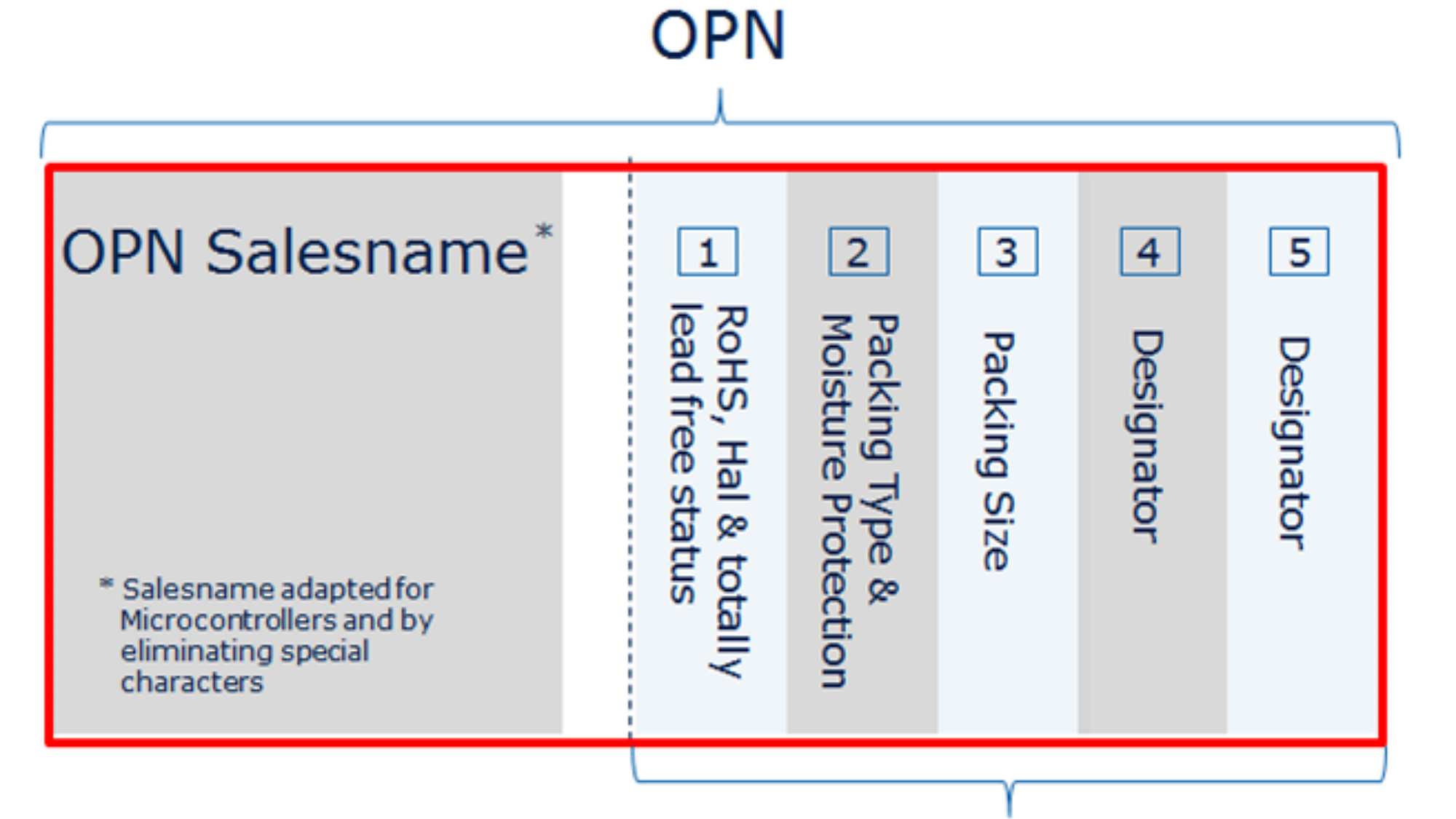
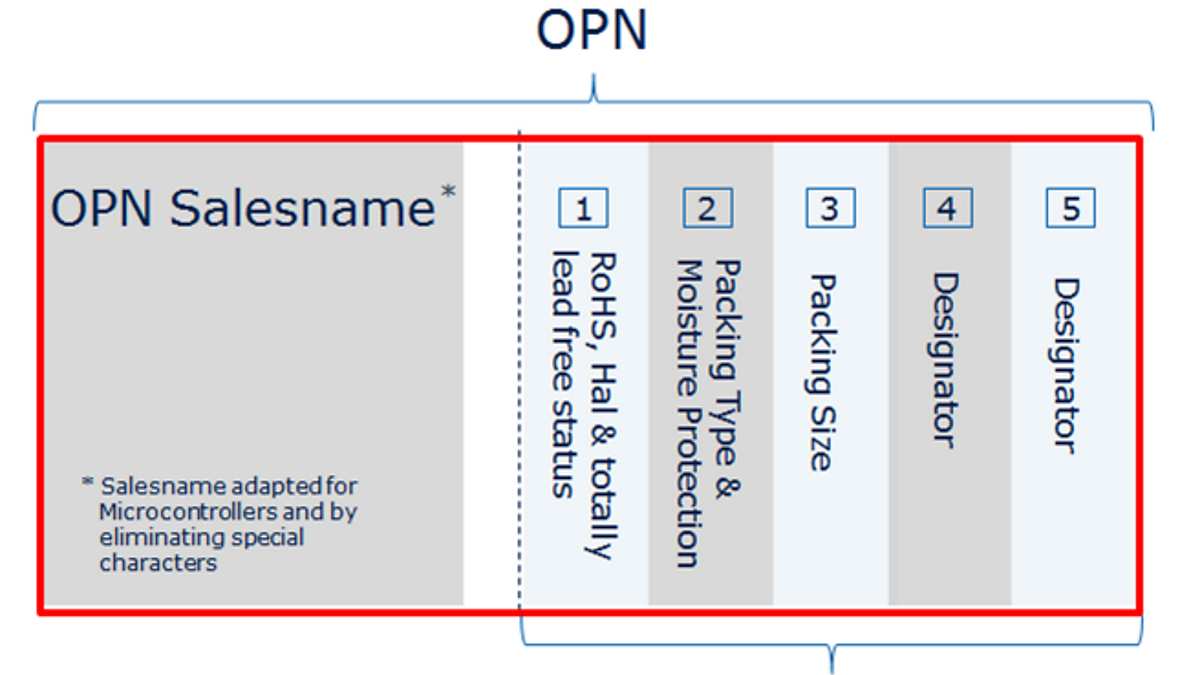
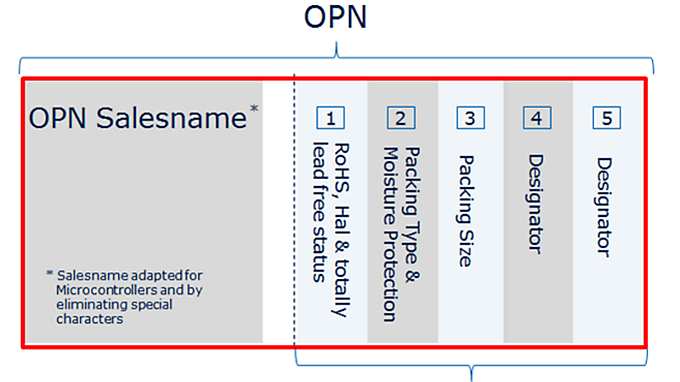
The Orderable Part Number consists of two parts: The OPN salesname and the OPN suffix.
Orderable Part Number OPN Identifiers
The descriptive identifiers within the OPN tell you more about the product attributes. Please find the related information below.
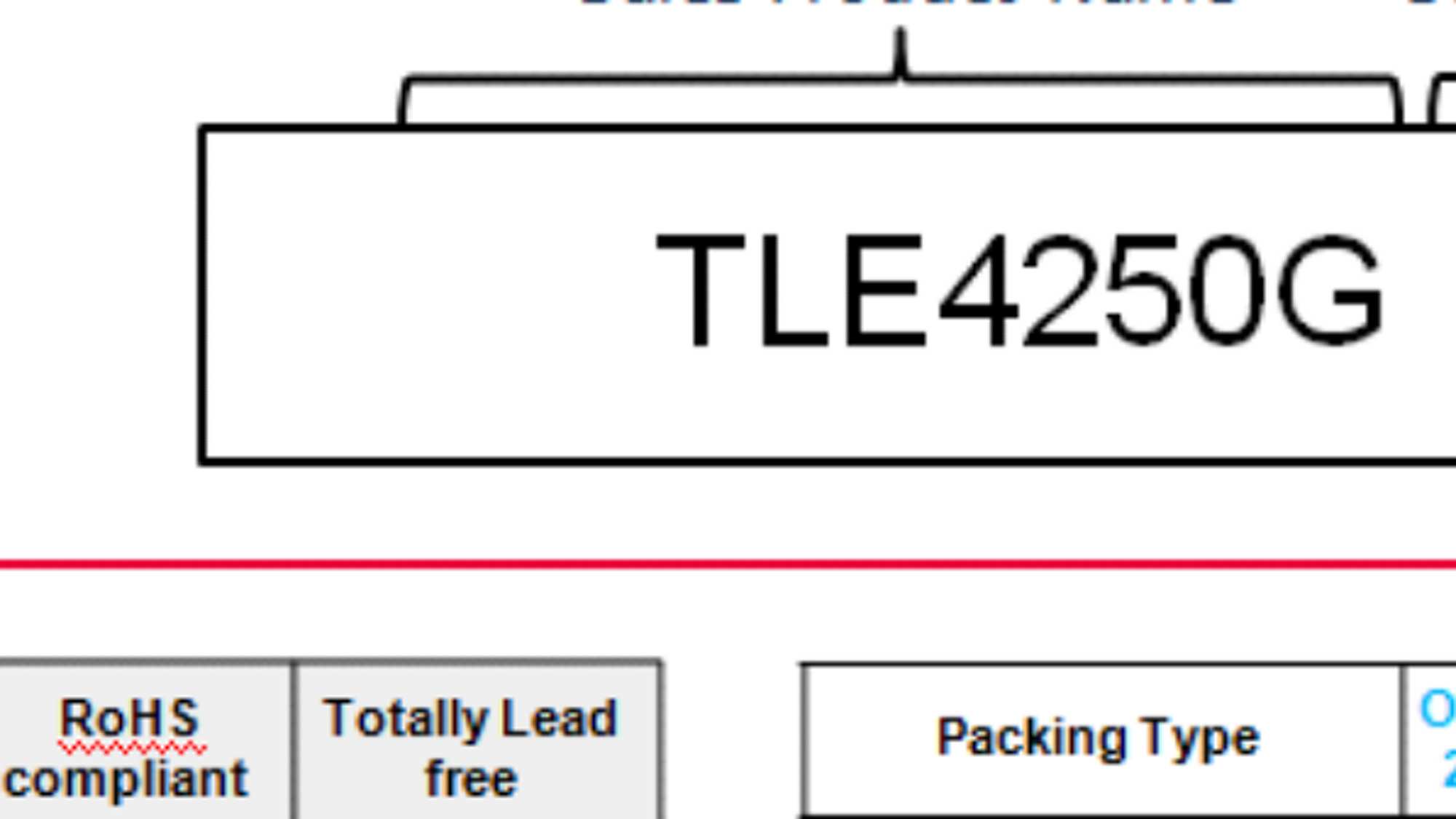
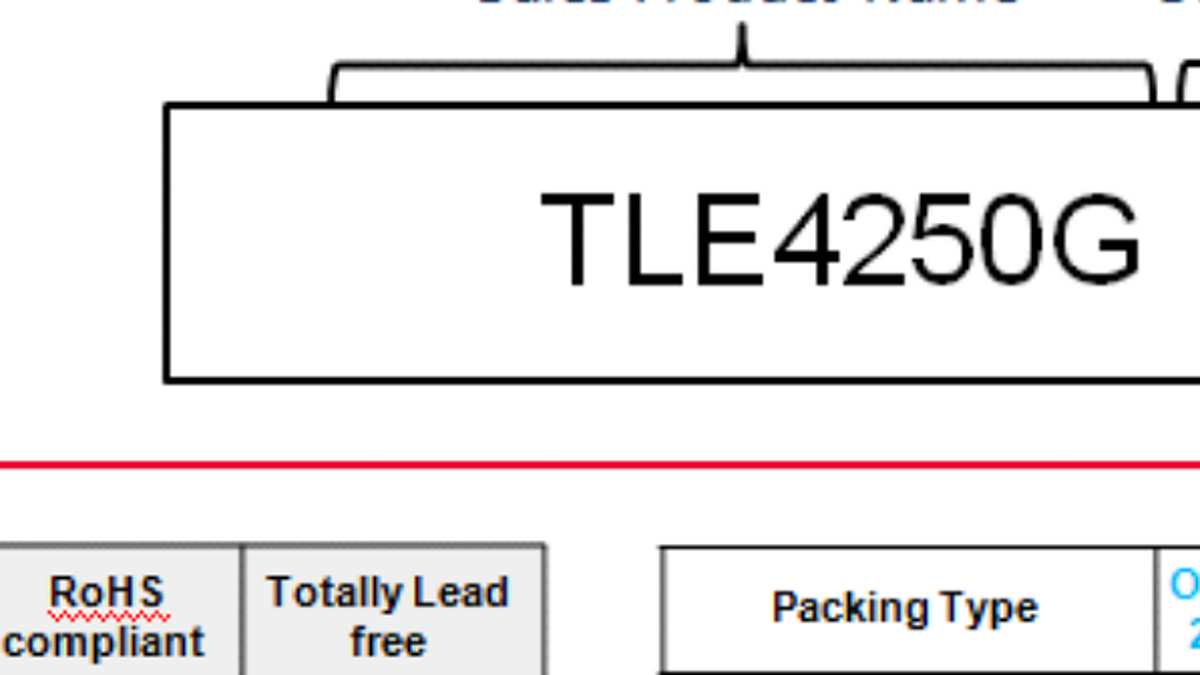
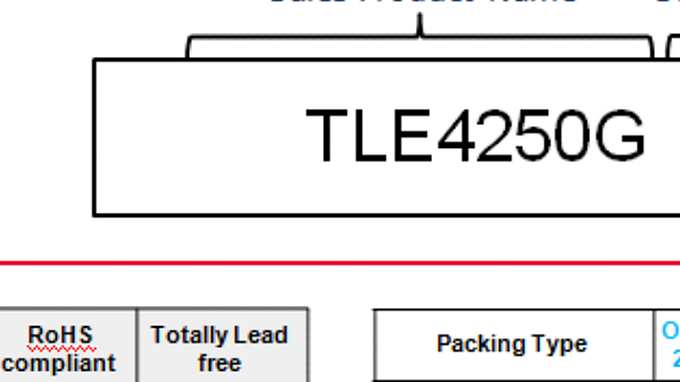
Example for an OPN (the OPN relevant suffix are the last 5 digits)
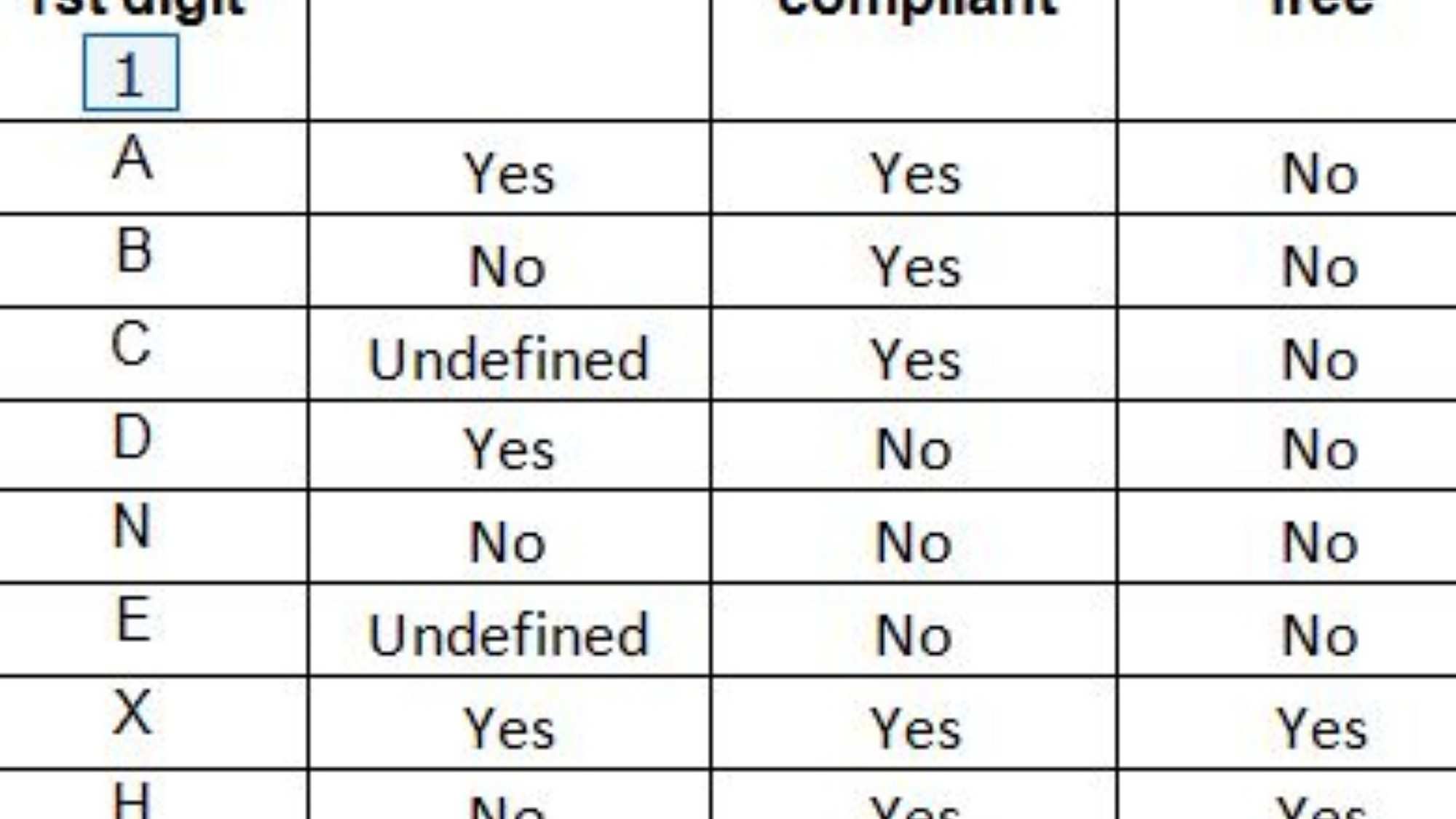
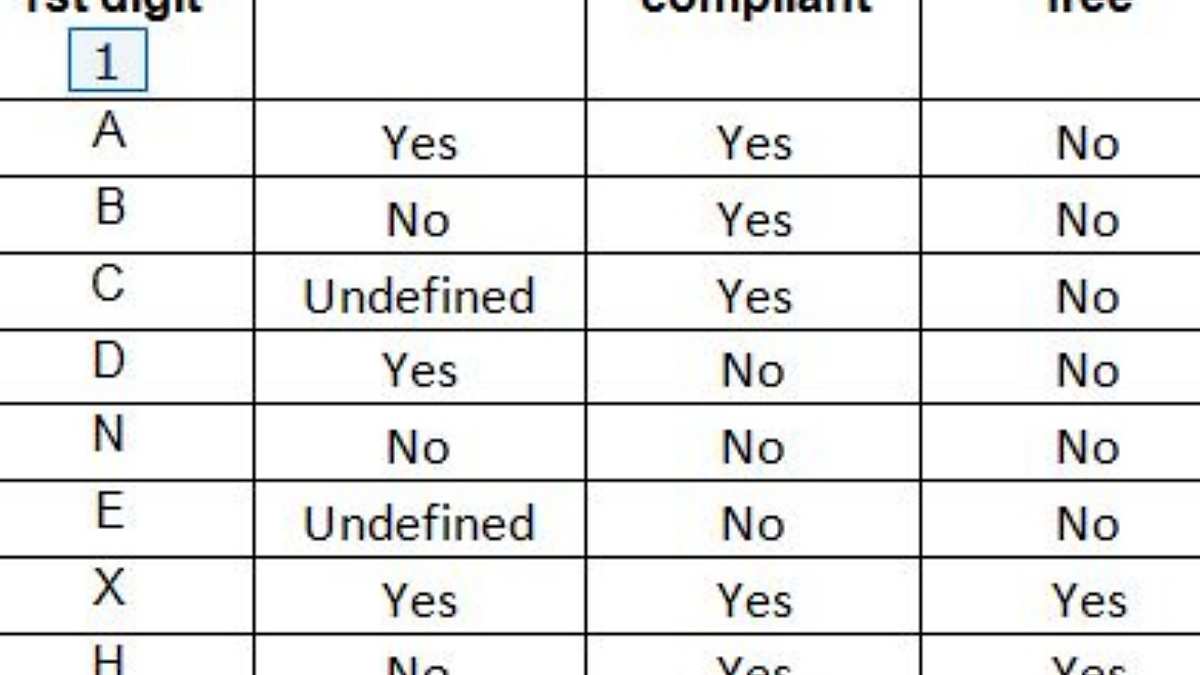
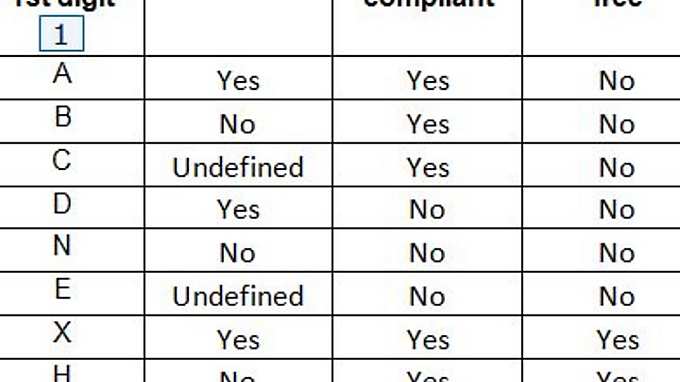
1st digit: RoHS, Halogen and Totally Lead Free Status
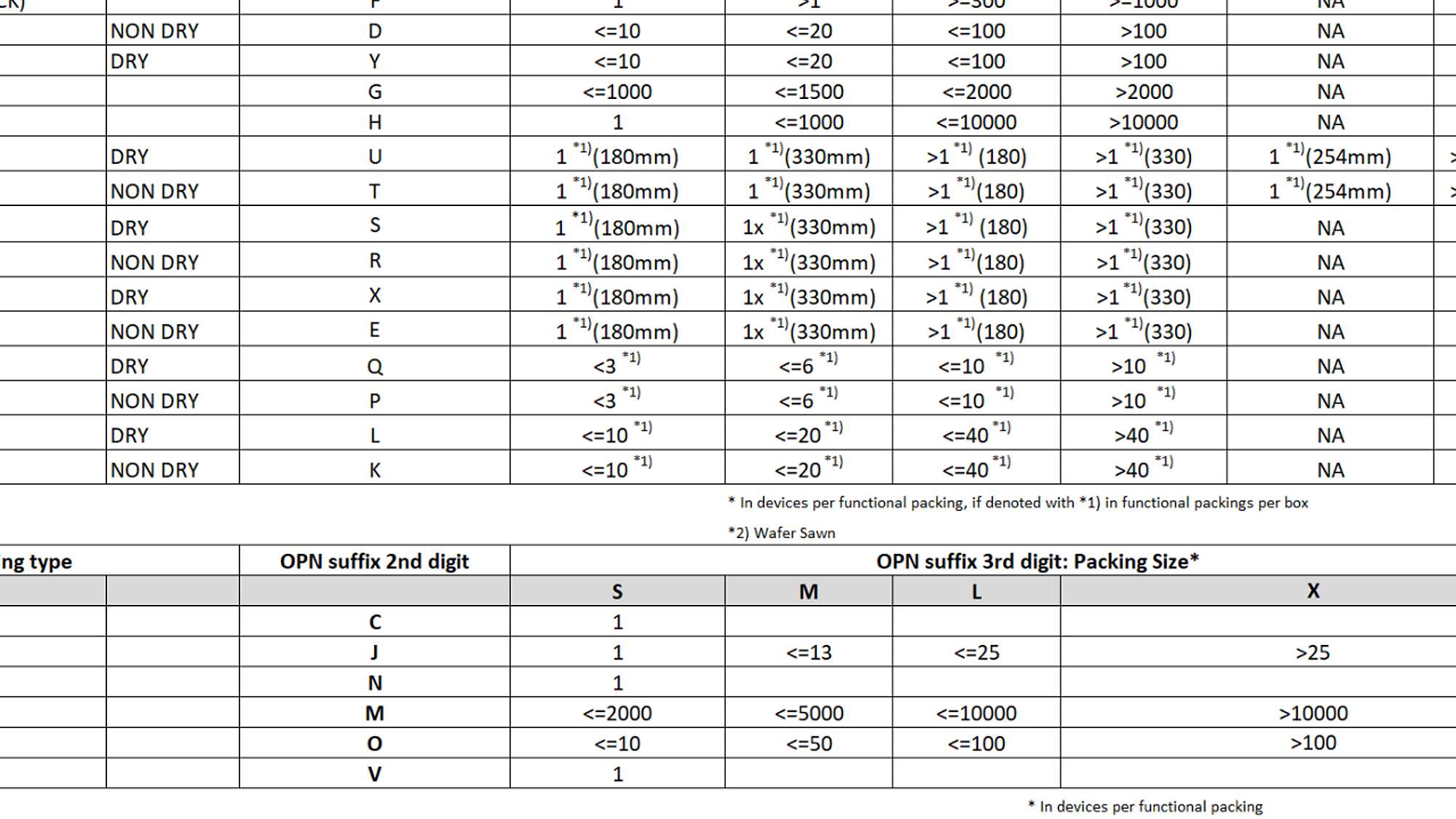
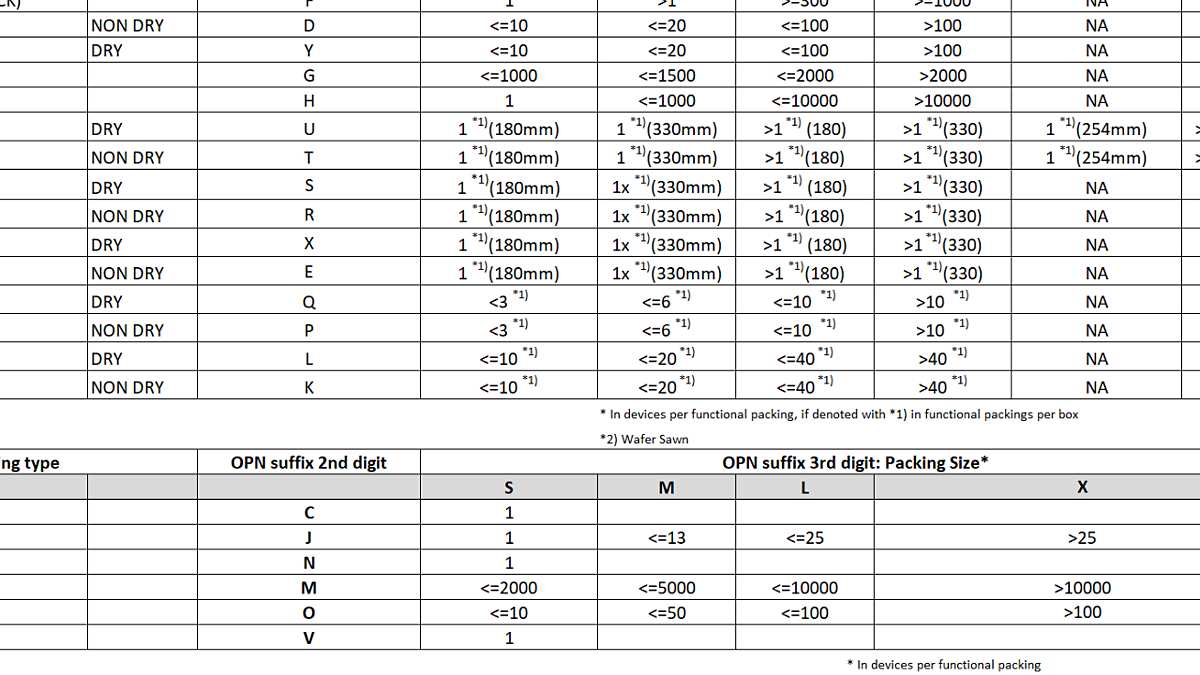
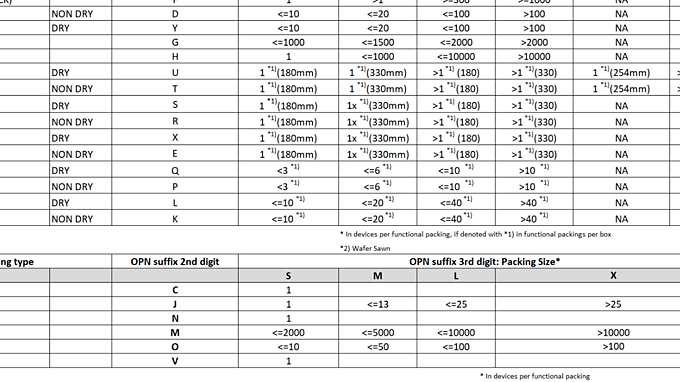
2nd and 3d digit: Packing type, Moisture Protection Packing and Packing Size
The 2nd digit shows the functional packing type in combination with the moisture protection packing.
The 3rd digit shows the number of devices per functional packing or the number of functional packings (denoted with 1)
Examples for packing type- and size
- TLE4250G with OPN TLE4250GNTSA1 and TLE4250GNTMA1. This product comes on two different reel sizes: 180mm and 330mm. One can see from the second digit that the product comes on tape & reel (T). Now the packing size can be determined by the third identifier. This product comes as “S” and “M”. “S” means 180mm, “M” means 330mm. Even if this detail was not known, it becomes obvious on first sight that TLE4250GNTSA1 is smaller than TLE4250GNTMA1.
- SAE800G with OPN SAE800GXLLA1. This product comes in Tubes (indicated by the “L” in the 2nd digit ). The third digit of the OPN is also an “L” which indicates that there are between 21 and 40 tubes per box.
- SIPC03S2N03L with OPN SIPC03S2N03LX3MA1. This product comes on Tape & Reel bare die (3). The third identifiers (M) indicates that there are between 2001 and 5000 bare dies on the reel.
Although none of the packing size indications gives an exact number of products per packing, it allows you to distinguish between two different products: You can immediately see which product
4th and 5th digit: Designator
The designator increments (e.g. from A1 to A2) whenever a new SP number is set up that does not differ from a previous product in either Salesname or the first three OPN suffix identifiers. Product variants such as different temperature ranges or ROM codes can therefore be recognized by the designator.
Existing identifiers
Currently there are two relevant product levels: Salesname and SP number. The salesname describes the functional attributes of a product (e.g. supply voltage, frequency, memory) and it is also contained in the pCPN that some customers use to order today. The SP number is the non-descriptive order relevant sub-level number to the salesname. The SP number is a concise relation to the actual part itself specifying the packing type or size, RoHS/Halogen distinctions, customer specific variants and other product variants such as temperature ranges. Because multiple SP numbers can be assigned to one salesname, the OPN is a unique and descriptive identifier with a 1:1 relation to the SP number.
How does the OPN fit into the existing part numbering scheme?
Because the SP number is the order relevant level, the OPN is a descriptive and unique identifier with a 1:1 relation to the SP number. The Salesname does not carry sufficient information for ordering because multiple SP numbers can be assigned to one salesname.
This is possible by combining the salesname and the following additional attributes:
- RoHS status
- Halogen status
- Totally lead free status
- Packing type
- Packing size
- Moisture protection packing
Because these are the main, but not the only reasons for many SP numbers under one salesname it is also possible to depict any other reason (e.g. test versions, micro codes) in the designator.
The OPN will replace the proposed Customer Part Number (pCPN) which could be used as a customer part number.
What is the OPN?
The OPN is a descriptive ordering code that consists of an adapted Infineon sales type (“ salesname”) and five additional digits describing the product in more detail. Descriptive means that the OPN can be "translated" into exact product attributes.
Why are the existing ordering codes not sufficient?
The order relevant ordering code is the SP number which is not descriptive though because it is simply a number that has no particular meaning. This means that you can´t see which product is behind the SP number (e.g. a discrete or microcontroller). It is also not possible to see differences between SP numbers. Our descriptive ordering code is the salesname. By knowing its nomenclature you can easily determine the product group and the product attributes. However, one Salesname (e.g. the microcontroller SAB C165-LM) can have several SP numbers. There are many reasons why this can happen: Different packing types, green and grey versions, customer specific versions etc. So using the SP number is not convenient because the product behind it is not visible, using the salesname is not sufficient because it can have many ordering codes. The OPN solves both problems by creating an ordering code on the SP level that shows all relevant attributes.
What is the structure of the OPN / how does the OPN look like?
The OPN consists of an adapted salesname plus five additional digits describing the product in more detail.
What is an adapted salesname?
Because special characters (e.g. commas, dots or dashes) can be disturbing, the OPN will not contain any special characters. That means that the adapted salesname is not equal to the regular salesname. For microcontroller products the adapted salesname will never show the "SA" prefix and the temperature identifier (third digit in the salesname) is moved to the end of the adapted salesname. In very few cases salesnames also had to be adapted slightly in addition to the deletion of special characters due to a maximum length of the OPN of 24 digits.
What is encoded in the OPN?
The OPN shows the RoHS status, the halogen status, the totally lead free status, the functional packing type and size as well as the moisture protection packing. Additionally you can see product variants in the last two digits: Every time a product doesn´t differ in its salesname or the attributes encoded in the OPN (RoHS, Halogen, Packing Type, Moisture Protection Packing and Packing Size), the designator increments.
How are the OPN attributes encoded?
The first OPN digit encodes RoHS, Halogen and totally lead free status, the second digit shows the combination of packing type and moisture protection packing and the third digit describes the packing size (e.g. 180mm reel or 330mm reel). Every attribute is shown by only one digit (e.g. 180mm = S).
The last two digits identify product variants.
Since the designator is non-speaking, how can I see what is behind that OPN?
There can be many reasons why a salesname has several ordering codes. To mention just a few examples: Customer specific versions, special test versions, ROM codes, different wafer thicknesses, different temperature ranges, different bonding wires etc. It is simply not possible to cover all of these reasons in a descriptive identifier.
Please refer to this answer if you want to know how to determine differences between designators.
How can I find the difference between two products with differing identifiers?
Most of the differences can be found in the Product Change Notification (PCN). If you can´t find the difference between OPNs (their designators) contact your sales person, call us at 00800 951 951 951 or write an email to support@infineon.com.
What is the maximum length of the OPN?
The OPN is limited to 24 digits.
What is the benefit of the OPN?
You can not only see the product and its attributes as you can in the salesname but also information about the RoHS status, the halogen status, the totally lead free status, the functional packing type and size as well as the moisture protection packing. You can also distinguish other product variants based on the designator.
The descriptive nature of the OPN and its order relevant level makes it easier to communicate: Talking about SP numbers is not convenient as they are simply numbers. Talking about Salesnames is not sufficient because one salesname can have several ordering codes.
Does every product have an OPN?
Yes, every productive product (except for Engineering Samples) has an OPN.
Can the OPN be used instead of the SP#?
No. The SP number is a vendors part number. Please talk to your sales contact if you plan to replace the SP# with the OPN.
Can the OPN be used instead of the Salesname?
In general - yes. The salesname can also only be used as a Customer Part Number because it is not unique. That means an order with the Salesname also needs to be translated into an SP number. Additionally it is possible that there are several SP numbers for one salesname which would increase the communication effort to find out the right SP number.
Which documents show the OPN?
The OPN is shown on the Barcode Packing Label in the 2D barcode and it is shown in the type list of PCNs, PDs and Infonotes. If you use the OPN as your Customer Part Number (You order with a part number different from the SP number) then the OPN is shown on all documents that currently display the CPN: Invoice, Packing List, Order Confirmation, Debit&Credit Notes, Dispatch Note etc.
Does the regular Label show the OPN?
Not yet in a form readable for the human eye. It is shown in field 50P in the 2D barcode (data matrix code).
Is the OPN in the datasheets?
No. The datasheet is based on an aggregate level. It is possible that one datasheet is valid for several SP Numbers or several Salesnames. Additionally new OPNs (new SP numbers) are created too frequently to update datasheets.
How can I order with the OPN?
The OPN is used as a customer part number (customer specific product name). For ordering purposes you tell us the OPN and we link it internally to the corresponding SP number. Now every time you order with the OPN we know the corresponding SP number.
If you would like to switch from your existing identifiers to the OPN, please contact your Infineon sales person.
Does the OPN replace any existing product name?
None of the official product names Salesname, SP number or MA number are replaced. However, several years ago we introduced the proposed customer part number (pCPN) which will be replaced by the OPN.
What do I need to do if I use the pCPN?
You can keep ordering with the pCPN because we still maintain the link between your pCPN and the SP number. However, we will not provide you with the pCPN in pricelists or any other document or system anymore.
We strongly recommend to use the OPN for ordering or as your internal identifier instead of the pCPN. If you want to switch to the OPN, please contact your Infineon sales person.
Do Samples have an OPN?
Yes, except for Engineering Samples all Samples have an OPN.
Is the information shown in the OPN true for samples?
Not necessarily. If a sample for product that comes on a 330mm reel is ordered it does not usually come on the reel itself.
Additionally it is possible that some sample attributes do not match the OPN attributes (e.g. OPN shows green but sample is grey).
Do Engineering Samples have an OPN?
No, Engineering Samples do not have an OPN.
Do Development Kits and Boards have an OPN?
Yes, Kits and Boards are marked with the OPN suffix "TOBO1…9" or “TOBP1…9”.
Where do I get translation tables for the OPN?
Translation tables can be found here.